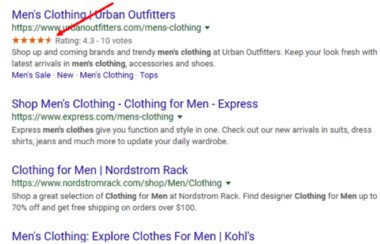Ecommerce is the present and the future.
Perhaps the clearest reminder of this happened recently when Sears filed for bankruptcy.
As more brick-and-mortar conglomerates bite the dust and online sales continue to climb, the ability of a smaller ecommerce brand to stand above the crowd will determine its life or death.
As many businesses know at this point, content marketing is the crucial ingredient for this task.
The landscape of content marketing is changing like crazy.
As the standards of SEO, web design, writing, etc. continue to evolve, businesses from all industries are continuously forced to refine their approaches.
The harsh reality is that some strategies can work like magic one day, then be completely obsolete the next.
Nowadays, the scope of what defines “good content” for ecommerce businesses is a layered concept that involves many elements.
Let’s discuss five ways ecommerce brands can establish themselves as a force to be reckoned with.
1. Prioritize E-A-T Score
One the most important recent changes to Google’s search quality ratings guidelines involved E-A-T score (Expertise, Authority, and Trustworthiness).
There is now a strong focus on applying this score to individual content creators, rather than brands themselves. The idea is to refine the way content is ranked based on the source.
For example, if someone is producing content and weight supplements, they should have a strong E-A-T score in the medical field.
So how does this factor in for ecommerce brands?
Google’s algorithms are designed to mimic hypothetical human quality raters.
That being said, if you want your product pages to rank highly on the SERPs, you need to find ways to improve your E-A-T score.
Expertise
You need to prove to the search engines (and the users) that you have a proven knowledge of the goods you sell.
As an ecommerce retailer, start by making sure that you work with highly reputable manufacturers.
If you make it a point to showcase that your suppliers/manufacturers have recognized expertise in your field, this is going to reflect on you.
Additionally, you can reach out to renowned figures with proven industry expertise to give you recommendations.
The functionality, aesthetics, and integrity of your website play a huge role in how experts will decide to recommend you and your products.
Authority
This is all about verifying Expertise.
In the ecommerce world, it’s easy for bigger companies that manufacture their own products (like L.L Bean and Nike) to be seen as highly authoritative.
Third-party sellers, on the other hand, need to have evidence that they are a verified merchant for certain products.
For example, if you have the Better Business Bureau logo linked to your website with verified affiliation, the page would likely rank higher.
Trustworthiness
Getting your product pages to rank well comes down to the concept of customer success. For instance:
- Do your product pages answer potential questions or concerns a buyer might have?
- Is it easy to get in contact with you?
- Is the return process clearly explained?
- Are there any unpleasant surprises in the checkout?
- Are there verified user ratings?
- Do the pages deploy HTTPS?
These are just a few pieces of the puzzle when it comes to building trust. Essentially, the more descriptive, intuitive, and secure your product pages are, the better they will rank.
E-A-T score has been building up in importance for some time now, and will continue to in the future. In order to get product pages ranked, these guidelines will need to play a key role in your content marketing strategy.
2. Integrate Video into Product Pages & Beyond
The biggest drawback of buying online has always been the inability to look at products in person. For the most part, you never really know what you are getting until it shows up on your doorstep.
Now, AR has been doing amazing things to remedy this problem.
However, most online brands aren’t IKEA – they don’t have the budget to spend on this flashy feature.
That being said, incorporating video into your product pages and content marketing plan should be a must. It’s no secret that the internet loves video content. In fact, it’s estimated that nearly 75 percent of all online traffic is video.
Starting with product pages, video does wonders to give buyers a visual understanding of what they are buying.
Seeing a real human handling the product is about as close as they can get to seeing it in person.
Take a look at this one from Saddleback Leather:
This video does a fantastic job of giving viewers everything they need to know about the product, along with some personal insight.
Simply put, images and descriptions of products can only get you so far.
Now, outside of the product page, you can use video to discuss the latest trends in your industry, compare items, bring in guests, etc.
Keep in mind, the search engines and social media (Facebook especially) favors video in their ranking algorithms.
Using video across the entire scope of your ecommerce content marketing plan does a lot to solidify your brand voice and values, as well as gives potential buyers all the information they need.
3. Focus on Qualified Reviews from Google Partners
Nearly everyone who has ever bought something online knows how much customer reviews can influence purchasing decisions.
Reviews are validation from a third-party source with no ulterior motives. That’s why reviews are extremely powerful in convincing people to buy.
Unfortunately, many companies and review services took advantage of this and would produce phony reviews in an attempt to increase customer confidence.
Over time, both consumers and the search engines wised up to this shady practice.
Reviews have been a ranking signal for a while, but Google has made it a point to favor those that are left via a verified Google Review Partner.
Partner platforms like Trustpilot and Yotpo do a lot to ensure all reviews are authentic and timely, and for that, Google sees them as credible resources. These verified reviews can do a lot to improve your Google Seller Ratings.
Moreover, review snippets help you stand out in organic search:

So, as an ecommerce brand, you are very wise to choose a verified Google Review Platform to collect and manage customer sentiment.
Many of these programs give you the ability to turn your reviews into visually appealing pieces of content that can be displayed on your website, social media, and more.

Reviews, testimonials, and all other forms of user-generated content are extremely powerful content marketing weapons, especially for ecommerce.
The rising importance of collecting and promoting positive sentiment is certainly a trend that will continue to grow.
4. Team Up with Micro-Influencers
A huge misconception exists about influencer marketing.
Many brands think that only the influencers with the largest followings are worth going after for a campaign.
In other words, when they are conducting their research for potential partners, they tend to put the number of followers as the top deciding factor.
This is not a smart move for smaller brands because it:
- Can be very expensive.
- Might not yield a good ROI.
That being said, smaller ecommerce businesses should make it a point to look into micro-influencers. In contrast to the megastars, the typical following of a micro-influencer is under 100,000.
Engagement levels tend to fall as an influencer gains more followers.
Accounts with 1,000 followers or less normally see an 8 percent like rate, whereas this number drops to about 4 percent in followings of 1,001-9,999.
The takeaway is that smaller followers tend to be more focused on the message. When it comes to influencer marketing, engagement will always be more important than the number of followers.
A couple of years ago, Banana Republic did a great job choosing micro-influencers to promote their products on Instagram.

By using a diverse set of industry influencers for different styles and hashtags, they were able to reach a plethora of different audience segments for relatively cheap!
So, instead of dumping all your budget on a single big name, you are wise to choose several different micro-influencers. Your engagement rates will likely be much higher and give you a better ROI.
5. Do It for a Cause
Cause marketing has been a huge buzzword in recent years. In the realm of content marketing, it can do wonders to create a more loyal and devoted customer base.
According to Edelman, 64 percent of consumers buy on belief, and will choose, switch, boycott, or avoid brands based on their standing in relation to a social issue.
Now, cause marketing can be a small as a monthly or annual contribution to a cause.
Or, the cause can define the brand itself.
Patagonia has been doing this successfully since day one.
As an ecommerce brand looking to get the ball rolling in cause marketing, several key factors come into play.
First and foremost, you need to choose a cause that has parallels with your business goals. If there are no congruencies, it will look like a cheap PR stunt.
KFC’s “Buckets for a Cure” campaign is a prime example of this type of failure. A few years back, KFC paired with the Susan G. Komen Foundation for breast cancer research and donated $0.50 for every bucket of chicken sold.
In terms of money raised, it was a great success. However, from a PR standpoint, it missed the mark horribly. This is because fried chicken simply has nothing to do with breast cancer.
Many would argue that greasy fast food can actually increase the risk of cancer! The lesson here is to choose a cause wisely and prove that you have a strong business devotion.
Next, once you’ve chosen a fitting cause, you need to figure out the details of how you will contribute.
- Will a portion of a purchase go toward the cause?
- Will it be a “buy one give one” deal?
- Will it be action-driven where customers can get involved themselves?
There are several types of cause marketing to consider. Be critical in your choice and understand how it will benefit both parties.
In a nutshell, cause marketing shows customers that their money is going to something greater than both themselves and the seller.
One of my favorite examples is TOMS’ One-for-One campaign.

When a customer purchases a pair of shoes from TOMS, the company donates a pair to children in developing countries. The campaign has given more than 35 million pairs of shoes to children in need.
Now, something like this might not be feasible for a small ecommerce operation. The most important thing is that you prove you are devoted and promote the fact that buying your product is making the world a better place.
Summary
There’s no denying that ecommerce businesses have it tough these days.
After all, they are going up against one of the biggest business giants to ever grace the world: Amazon.
If you look at all the successful ecommerce brands out there (aside from Amazon and eBay), the biggest common thread is that they produce and distribute stellar content.
If you are looking to gain traction for your ecommerce store, keep these five strategies in mind.
More Content Marketing Resources:
- How Ecommerce Websites Can Achieve E-A-T Quality
- 10 Awesome Evergreen Content Ideas for Ecommerce Websites
- The Hidden Opportunity for Ecommerce Websites in Google Images
Image Credits
Screenshots taken by author, October 2018




